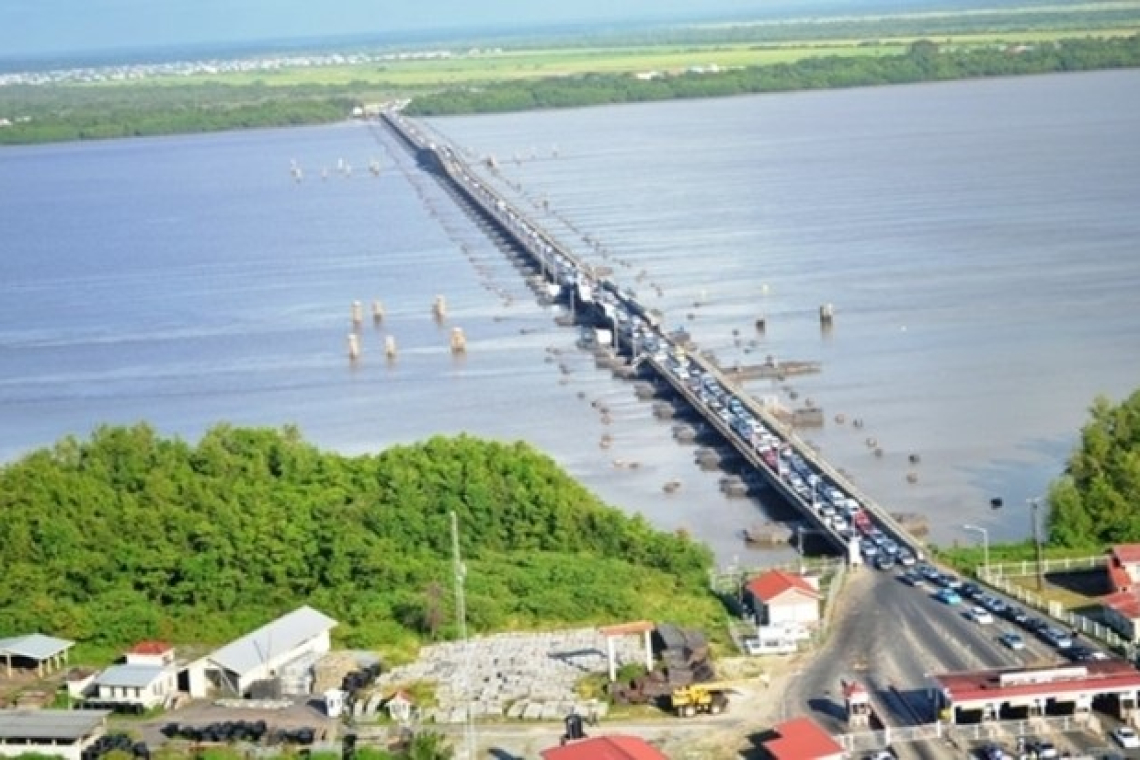The Demerara Harbour Bridge.
GEORGETOWN, Guyana--For decades, it groaned beneath the weight of cars, trucks, and time itself, a steel spine holding two of Guyana’s major coasts together. But as plans for the new Demerara River Bridge come to fruition, the existing Demerara Harbour Bridge (DHB) now stands like a weary veteran at sunset, watching its younger replacement on the horizon.
Stretching some 1.85 kilometres (6,078 feet) across the Demerara River, the floating steel bridge connects Peter’s Hall on the East Bank to Versailles on the West Bank. It has long served as both a lifeline and a landmark for Guyanese commuters, traders, and travellers.
The Demerara Harbour Bridge consists of 61 spans of floats of varying lengths on 122 steel pontoons, making it the fifth-longest floating bridge in the world as of 2016. It also has a horizontal clearance at its retractor span of 77.4 meters to accommodate the passage of marine vessels.
Built over two years and opened on July 2, 1978, the ‘Harbour Bridge’ was the third structure across the Demerara River – the Hope and Mackenzie-Wismar Bridges, both in Region 10, being the first two – and is the only floating bridge to span the Demerara River.
Initially, the Demerara Harbour Bridge was built to last just 10 years, but has since outlived its life span for several decades. In fact, billions have been spent over the years to maintain the bridge and keep it afloat to serve the public.
Approximately 14,000 vehicles traverse the bridge on a daily basis, earning the bridge company some $100 million in 2024.
Previously, commuters paid a one-way toll on the eastern side of the bridge of $40 for motorcycles, $200 for cars and minibuses and $700 for motor lorries. However, crossing at the bridge, along with the Wismar and Berbice bridges, became toll-free as of August 1, 2025 – a move by the Dr Irfaan Ali-led People’s Progressive Party/Civic (PPP/C) Administration.
In a matter of hours, President Ali will be commissioning the newly built, modern fixed-span, cable-stayed US$262 Demerara River Bridge – a concrete structure that will allow toll-free and uninterrupted crossing for both vehicular and marine traffic, thus bringing an end to daily, hours-long traffic congestion at both ends of the Harbour Bridge.
As the new bridge promises faster travel and greater safety, for many, the transition marks the end of an era and the beginning of bittersweet memories.
“It’s a mix of emotions…” Speaking to this publication, Guyanese Leza Singh reflected on the emotional connection she has with the old bridge – one that many also share.
“Honestly, it’s a mix of emotions for me. That old Demerara Harbour Bridge has been a huge part of my life. I crossed it every single day going to school and later to university. So many mornings started there, sitting in long lines of traffic, sometimes for hours, and even watching the sun rise or set as I made my way to or from home.” Singh recalled the frustrations of daily travel, describing the traffic at times as “hell”.
“Despite the traffic, the bridge felt like part of our daily story. It connected us, gave us access to opportunities, and for so long it was something we were proud of, especially knowing it held the title of the longest floating bridge in the world. It’s like watching a piece of our history fade.”
Amidst these feelings, Singh expressed relief that Guyana is finally getting a modern bridge, “But at the same time, I’m relieved we’re moving toward something safer and faster. After all those years stuck in that endless line, I think we’ve earned an upgrade. I know a new bridge won’t magically fix all our traffic problems, but it’s definitely going to ease the pressure tremendously. But I do hope the old bridge is remembered properly; it deserves respect for how much it served this country.”
“It’s kind of sad to see a legacy go…” Meanwhile, Amrita Khoshall, a resident on the East Bank who frequently travelled across the bridge, shared similar sentiments. “So, I think we can all agree that the new Demerara Harbour Bridge is the most progressive bridge Guyana has ever seen – and a lot of people have even gone so far as to say that. But for some of us, it comes with a wave of emotion. The old Demerara Harbour Bridge is the only one we’ve ever known, so it’s kind of sad to see such a legacy go.”
Providing context about the historical bridge, she recalled a touching childhood memory that she holds dear, “It’s one of the longest floating bridges in the world, and I’m sure it will serve another purpose in the future – but still, it’s emotional. I remember when I was a child, every time we crossed the bridge, my mother would give me a coin to throw into the river. That was a core memory for me. Now, when I look at the new bridge rising in the distance, I can’t help but feel emotional while driving by. It’s progress, yes – but it’s also the closing of a chapter we’ve all lived.”
Another resident, Patricia John, expressed relief and optimism about the Government’s efforts to modernise the country’s infrastructure. “Because it’s been so long that we’ve been waiting for this new bridge, and having the Government take this initiative to give us this – also knowing that we wouldn’t have to pay – it’s absolutely a great initiative that the Government has undertaken.”
Though her words were simple, they capture a wider public sentiment: a quiet gratitude that progress has finally arrived, coupled with hope that the new bridge will bring greater convenience and opportunity for all. For decades, the Demerara Harbour Bridge has done more than connect two points – it has connected people, livelihoods, and dreams. It carried schoolchildren and workers, lovers and vendors, all crossing its metal planks as the river below reflected Guyana’s changing skyline.
However, the Guyana Government plans to repurpose and utilise the steel structure to bridge other major waterways across the country. In fact, it has been confirmed that sections of the Demerara Harbour Bridge will be going towards connecting Timehri to Sandhills, a small village located on the Demerara River just opposite the Cheddi Jagan International Airport (CJIA). ~Inews Guyana~







